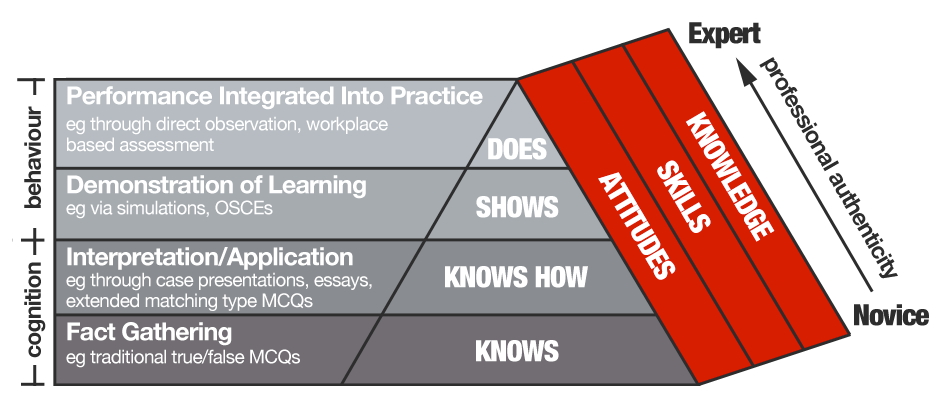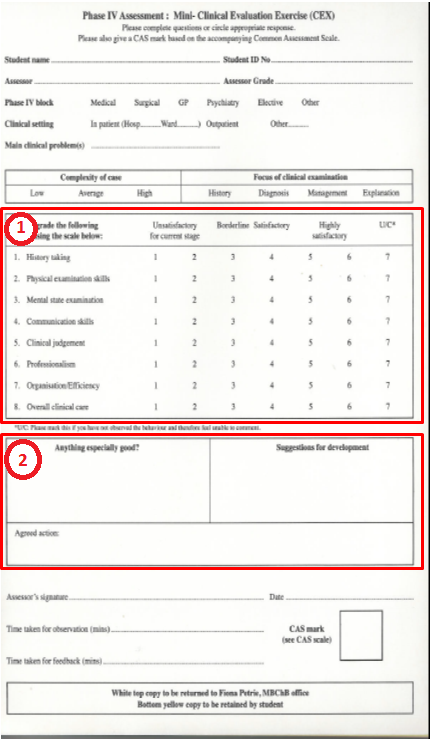What are Workplace Based Assessments?
Contents
- Description of Different Workplace Based Assessments
- Which Students Perform these Assessments
- Typical Mini-CEX Assessment
- Typical DOPS Assessment
- Typical Paperwork
Workplace Based Assessments (WBAs) are assessments of a doctor or student's performance in the workplace. The provision of feedback is an integral part of the WBA assessment. Commonly used workplace assessments include
- Mini Clinical Examination (Mini-CEX)
- Case based discussion (CBD)
- Directly observed procedure (DOPS)
- multi-source feedback (MSF)
Workplace based assessments were introduced into the postgraduate curriculum in 2005 because there were concerns that the high stakes examinations like OSCEs and single best answer questions encouraged rote learning. It is also known that performance in a controlled assessment correlates poorly with actual performance in professional practice (Rethans et al., 2002). Workplace based assessments aim to encourage authentic learning by asking students to solve real life clinical problems. They aim to assess what the student actually does in the clinical environment (see below).
A conceptual model of clinical competence is Miller's pyramid. The different layers represent the different components of clinical competency and how they can be assessed. Workplace assessments attempt to assess how an individual performs in the workplace i.e. what they actually do.
Miller's Prism of Clinical Competence (aka Miller's Pyramid)
It is only in the 'does' triangle that the doctor truly performs

Description of Different Workplace Based Assessments
- Mini-Clinical Examination Exercise (mini-CEX): A senior clinician observes a clinical encounter, provides feedback and completes a form including grades and written comments.
- Multisource feedback (MSF): nominated colleagues rate trainees on a Likert scale and give optional free text feedback on the trainee's communication, leadership and team working skills (Wilkinson et al 2008).
- Directly Observed Procedural Skills (DOPS): the performance of students in practical procedures using a checklist (Wilkinson et al 2008)
- Case based discussions. A real case that the student has been involved in is discussed focusing on either clinical reasoning or decision-making and application of medical knowledge.
Which Students Perform these Assessments:
Fourth year students: Workplace based assessments are being introduced into some blocks.
Fifth year students.
- Formative mini-CEX assessments
- Summative mini-CEX assessments
- Formative DOPS: core procedural skills
- Formative prescribing directly observed procedure
Typical Mini-CEX Assessment
- Students are generally responsible for arranging their own assessments by asking a senior clinician to perform the assessment and agreeing a time.
- A senior clinician is a:
- senior specialist trainee
- associate specialist
- consultant
- general practitioner
- It is preferable to have a different assessor for each assessment. Ideally the assessments should be evenly spaced out over the year.
- The assessor should select a willing and appropriate patient.
- The student should be directed to perform a relevant history and examination, which may also cover investigation and diagnosis.
- The observation should take approximately 15-20 minutes.
- Each mini-CEX has specific descriptors to be marked on a numerical scale and comments should be made on good performance and areas for development.
- Immediate verbal feedback should be given to the student in a quiet area for approximately 5 minutes.
Typical DOPS Assessment
- Students are responsible for arranging their own assessments by asking a healthcare professional to perform the assessment and agreeing a time.
- A healthcare professional that can perform a DOPS must be able to perform the practical procedure being observed.
- Examples of procedures suitable for DOPS include: venesection, safe disposal of 'sharps', catheterisation, measuring blood glucose, ECG, urinalysis, skin suturing and hand washing.
- The full procedure should be observed and immediate verbal feedback given over 5 minutes or less.
- Each DOPS has specific descriptors to be marked on a numerical scale and space for assessor's comments.
Typical Paperwork
PDF of a 5th Year Mini CEX Mark Sheet (Whole)

1. There are 8 question areas to grade on each form.
These are graded from 1-6 with 1 being unsatisfactory and 6 highly satisfactory.
If you have not observed the behaviour please circle number 7.
The descriptors for each question area are as follows (? As hyperlink).
2. One of the most important aspects of a mini CEX is feedback see feedback Please document descriptions of good behaviour and suggestions for development. It is important to agree an action plan with the student so the feedback can be used for development
Mini-CEX: Competencies Assessed and Descriptors
| Question area: | Descriptor for satisfactory trainee: |
|---|---|
| History taking | Facilitates patient's telling of story, effectively uses appropriate questions to obtain accurate, adequate information, responds appropriately to verbal and non-verbal cues |
| Physical examination | Follows efficient, logical sequence; examination appropriate to clinical problem, explains to patient; sensitive to patient's comfort, modesty |
| Professionalism | Shows respect, compassion, empathy, establishes trust; Attends to patients needs of comfort, respect, confidentiality. Behaves in an ethical manner, awareness of relevant legal frameworks. Aware of limitations |
| Clinical judgement | Make appropriate diagnosis and formulates a suitable management plan. Selectively orders/performs appropriate diagnostic studies, considers risk, benefits |
| Communication skills | Explorers patients perspective, jargon free, open and honest, empathic, agrees management plan/therapy with patient |
| Organisation/efficiency | Prioritises; is timely, succinct. Summarises |
| Overall clinical care | Demonstrates satisfactory clinical judgement, synthesis, caring, effectiveness, Efficiency, appropriate use of resources, balances risks and benefits, aware of own limitations |